Analysis of Communication Needs and Systems in a Business Environment
VerifiedAdded on 2020/06/06
|11
|2953
|63
Report
AI Summary
This report delves into the critical aspects of business communication, examining the communication needs of both internal and external stakeholders. It analyzes various communication models, including Shannon and Weaver, Schramm, and Berlo's models, to understand the communication process and potential pitfalls. The report discusses the effectiveness of different communication systems like telephone calls and email, and the factors that influence the choice of communication media. It emphasizes the importance of correct grammar, punctuation, and spelling in business communications, along with planning and structuring different communication media. Furthermore, the report explores ways to overcome barriers to communication, the use of communication theories, and the significance of body language. It also explains proofreading techniques for business communications and identifies the purpose, audience, and appropriate media for communication. The report covers presenting information in the correct format, layout, and style, adhering to agreed business practices, adapting communication styles for specific audiences, and ensuring clarity and accuracy in written communications. It also addresses meeting deadlines and using appropriate language and body language in verbal communication. Finally, the report identifies the nature, purpose, audience, and use of information, ensuring the recipient understands the communicated message.
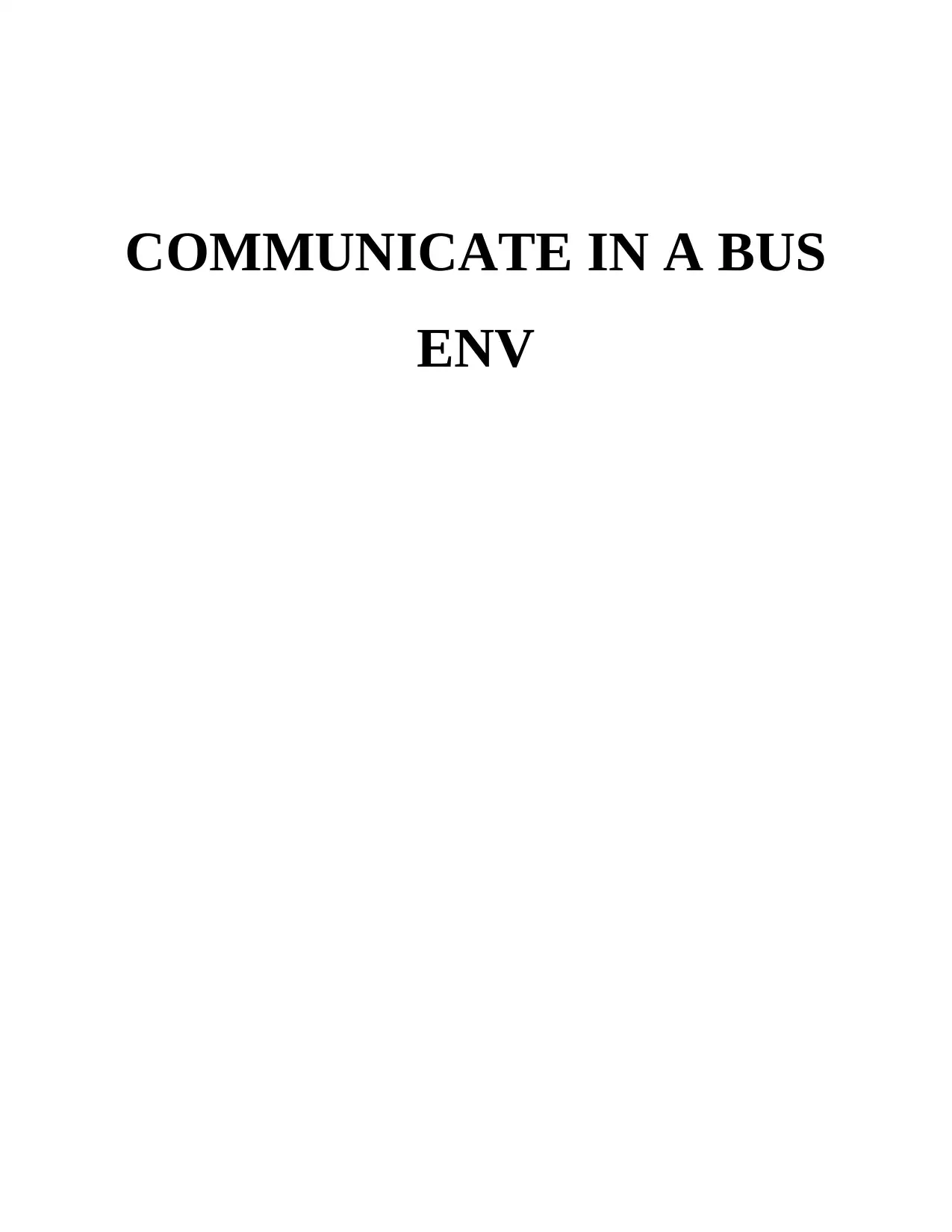
COMMUNICATE IN A BUS
ENV
ENV
Paraphrase This Document
Need a fresh take? Get an instant paraphrase of this document with our AI Paraphraser
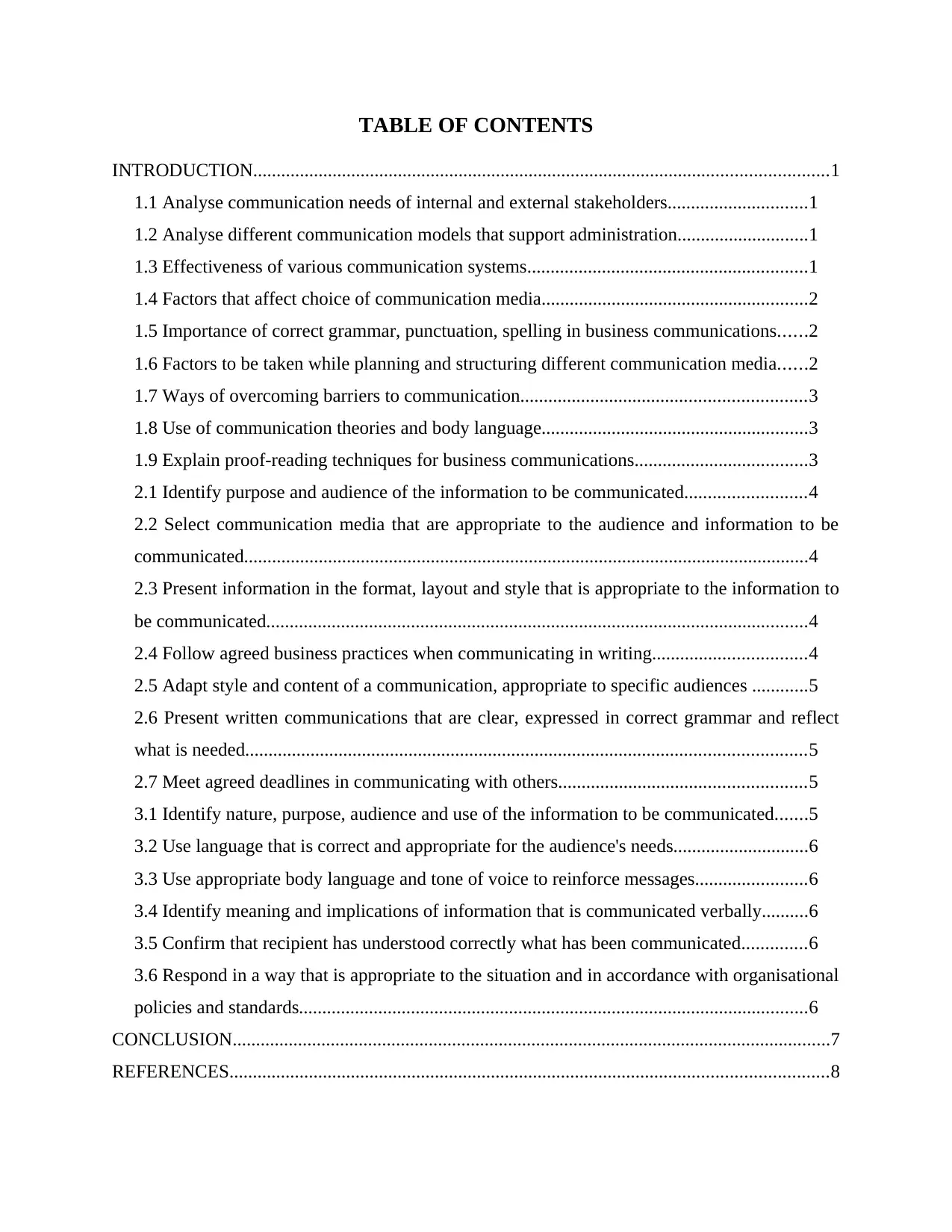
TABLE OF CONTENTS
INTRODUCTION...........................................................................................................................1
1.1 Analyse communication needs of internal and external stakeholders..............................1
1.2 Analyse different communication models that support administration............................1
1.3 Effectiveness of various communication systems............................................................1
1.4 Factors that affect choice of communication media.........................................................2
1.5 Importance of correct grammar, punctuation, spelling in business communications......2
1.6 Factors to be taken while planning and structuring different communication media......2
1.7 Ways of overcoming barriers to communication.............................................................3
1.8 Use of communication theories and body language.........................................................3
1.9 Explain proof-reading techniques for business communications.....................................3
2.1 Identify purpose and audience of the information to be communicated..........................4
2.2 Select communication media that are appropriate to the audience and information to be
communicated.........................................................................................................................4
2.3 Present information in the format, layout and style that is appropriate to the information to
be communicated....................................................................................................................4
2.4 Follow agreed business practices when communicating in writing.................................4
2.5 Adapt style and content of a communication, appropriate to specific audiences ............5
2.6 Present written communications that are clear, expressed in correct grammar and reflect
what is needed........................................................................................................................5
2.7 Meet agreed deadlines in communicating with others.....................................................5
3.1 Identify nature, purpose, audience and use of the information to be communicated.......5
3.2 Use language that is correct and appropriate for the audience's needs.............................6
3.3 Use appropriate body language and tone of voice to reinforce messages........................6
3.4 Identify meaning and implications of information that is communicated verbally..........6
3.5 Confirm that recipient has understood correctly what has been communicated..............6
3.6 Respond in a way that is appropriate to the situation and in accordance with organisational
policies and standards.............................................................................................................6
CONCLUSION................................................................................................................................7
REFERENCES................................................................................................................................8
INTRODUCTION...........................................................................................................................1
1.1 Analyse communication needs of internal and external stakeholders..............................1
1.2 Analyse different communication models that support administration............................1
1.3 Effectiveness of various communication systems............................................................1
1.4 Factors that affect choice of communication media.........................................................2
1.5 Importance of correct grammar, punctuation, spelling in business communications......2
1.6 Factors to be taken while planning and structuring different communication media......2
1.7 Ways of overcoming barriers to communication.............................................................3
1.8 Use of communication theories and body language.........................................................3
1.9 Explain proof-reading techniques for business communications.....................................3
2.1 Identify purpose and audience of the information to be communicated..........................4
2.2 Select communication media that are appropriate to the audience and information to be
communicated.........................................................................................................................4
2.3 Present information in the format, layout and style that is appropriate to the information to
be communicated....................................................................................................................4
2.4 Follow agreed business practices when communicating in writing.................................4
2.5 Adapt style and content of a communication, appropriate to specific audiences ............5
2.6 Present written communications that are clear, expressed in correct grammar and reflect
what is needed........................................................................................................................5
2.7 Meet agreed deadlines in communicating with others.....................................................5
3.1 Identify nature, purpose, audience and use of the information to be communicated.......5
3.2 Use language that is correct and appropriate for the audience's needs.............................6
3.3 Use appropriate body language and tone of voice to reinforce messages........................6
3.4 Identify meaning and implications of information that is communicated verbally..........6
3.5 Confirm that recipient has understood correctly what has been communicated..............6
3.6 Respond in a way that is appropriate to the situation and in accordance with organisational
policies and standards.............................................................................................................6
CONCLUSION................................................................................................................................7
REFERENCES................................................................................................................................8

⊘ This is a preview!⊘
Do you want full access?
Subscribe today to unlock all pages.

Trusted by 1+ million students worldwide
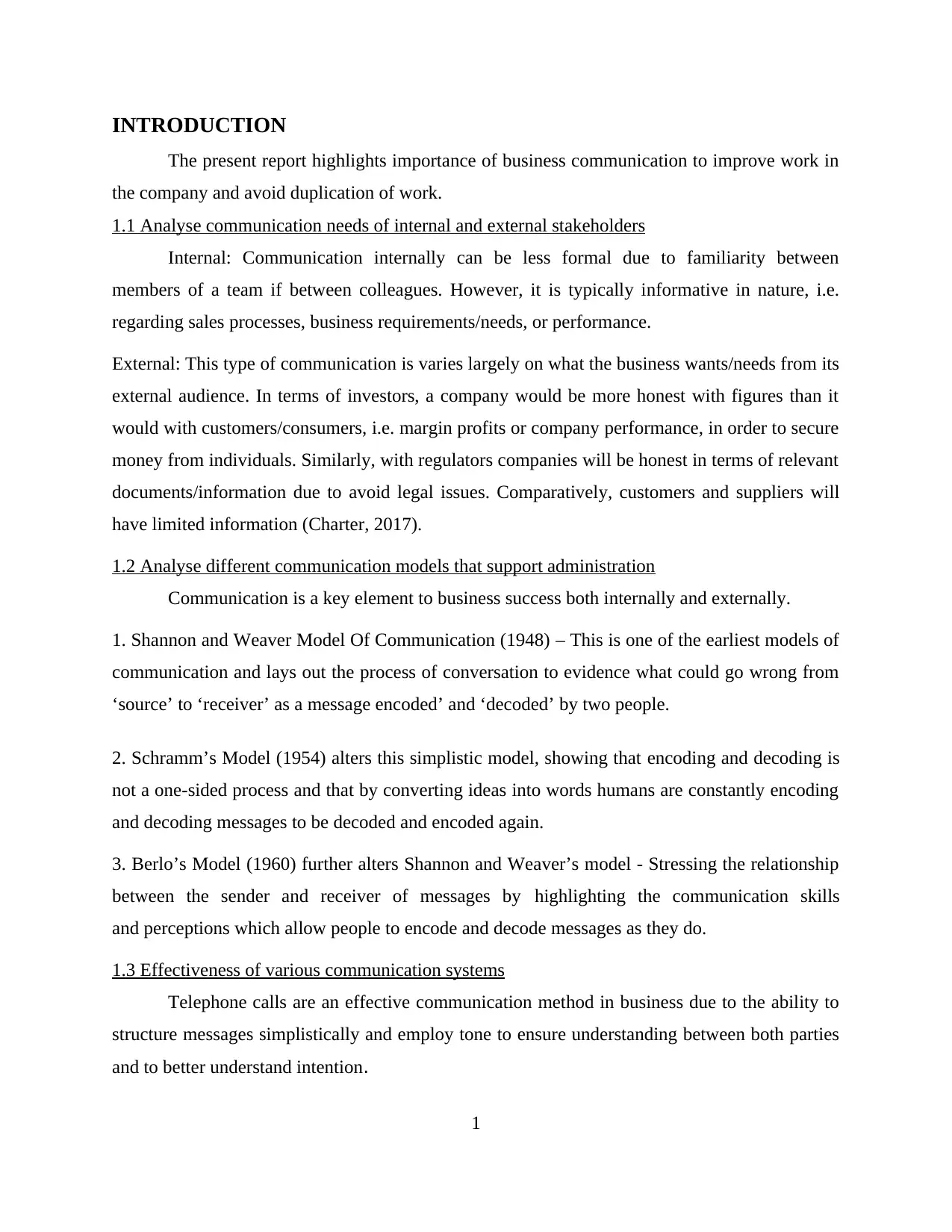
INTRODUCTION
The present report highlights importance of business communication to improve work in
the company and avoid duplication of work.
1.1 Analyse communication needs of internal and external stakeholders
Internal: Communication internally can be less formal due to familiarity between
members of a team if between colleagues. However, it is typically informative in nature, i.e.
regarding sales processes, business requirements/needs, or performance.
External: This type of communication is varies largely on what the business wants/needs from its
external audience. In terms of investors, a company would be more honest with figures than it
would with customers/consumers, i.e. margin profits or company performance, in order to secure
money from individuals. Similarly, with regulators companies will be honest in terms of relevant
documents/information due to avoid legal issues. Comparatively, customers and suppliers will
have limited information (Charter, 2017).
1.2 Analyse different communication models that support administration
Communication is a key element to business success both internally and externally.
1. Shannon and Weaver Model Of Communication (1948) – This is one of the earliest models of
communication and lays out the process of conversation to evidence what could go wrong from
‘source’ to ‘receiver’ as a message encoded’ and ‘decoded’ by two people.
2. Schramm’s Model (1954) alters this simplistic model, showing that encoding and decoding is
not a one-sided process and that by converting ideas into words humans are constantly encoding
and decoding messages to be decoded and encoded again.
3. Berlo’s Model (1960) further alters Shannon and Weaver’s model - Stressing the relationship
between the sender and receiver of messages by highlighting the communication skills
and perceptions which allow people to encode and decode messages as they do.
1.3 Effectiveness of various communication systems
Telephone calls are an effective communication method in business due to the ability to
structure messages simplistically and employ tone to ensure understanding between both parties
and to better understand intention.
1
The present report highlights importance of business communication to improve work in
the company and avoid duplication of work.
1.1 Analyse communication needs of internal and external stakeholders
Internal: Communication internally can be less formal due to familiarity between
members of a team if between colleagues. However, it is typically informative in nature, i.e.
regarding sales processes, business requirements/needs, or performance.
External: This type of communication is varies largely on what the business wants/needs from its
external audience. In terms of investors, a company would be more honest with figures than it
would with customers/consumers, i.e. margin profits or company performance, in order to secure
money from individuals. Similarly, with regulators companies will be honest in terms of relevant
documents/information due to avoid legal issues. Comparatively, customers and suppliers will
have limited information (Charter, 2017).
1.2 Analyse different communication models that support administration
Communication is a key element to business success both internally and externally.
1. Shannon and Weaver Model Of Communication (1948) – This is one of the earliest models of
communication and lays out the process of conversation to evidence what could go wrong from
‘source’ to ‘receiver’ as a message encoded’ and ‘decoded’ by two people.
2. Schramm’s Model (1954) alters this simplistic model, showing that encoding and decoding is
not a one-sided process and that by converting ideas into words humans are constantly encoding
and decoding messages to be decoded and encoded again.
3. Berlo’s Model (1960) further alters Shannon and Weaver’s model - Stressing the relationship
between the sender and receiver of messages by highlighting the communication skills
and perceptions which allow people to encode and decode messages as they do.
1.3 Effectiveness of various communication systems
Telephone calls are an effective communication method in business due to the ability to
structure messages simplistically and employ tone to ensure understanding between both parties
and to better understand intention.
1
Paraphrase This Document
Need a fresh take? Get an instant paraphrase of this document with our AI Paraphraser
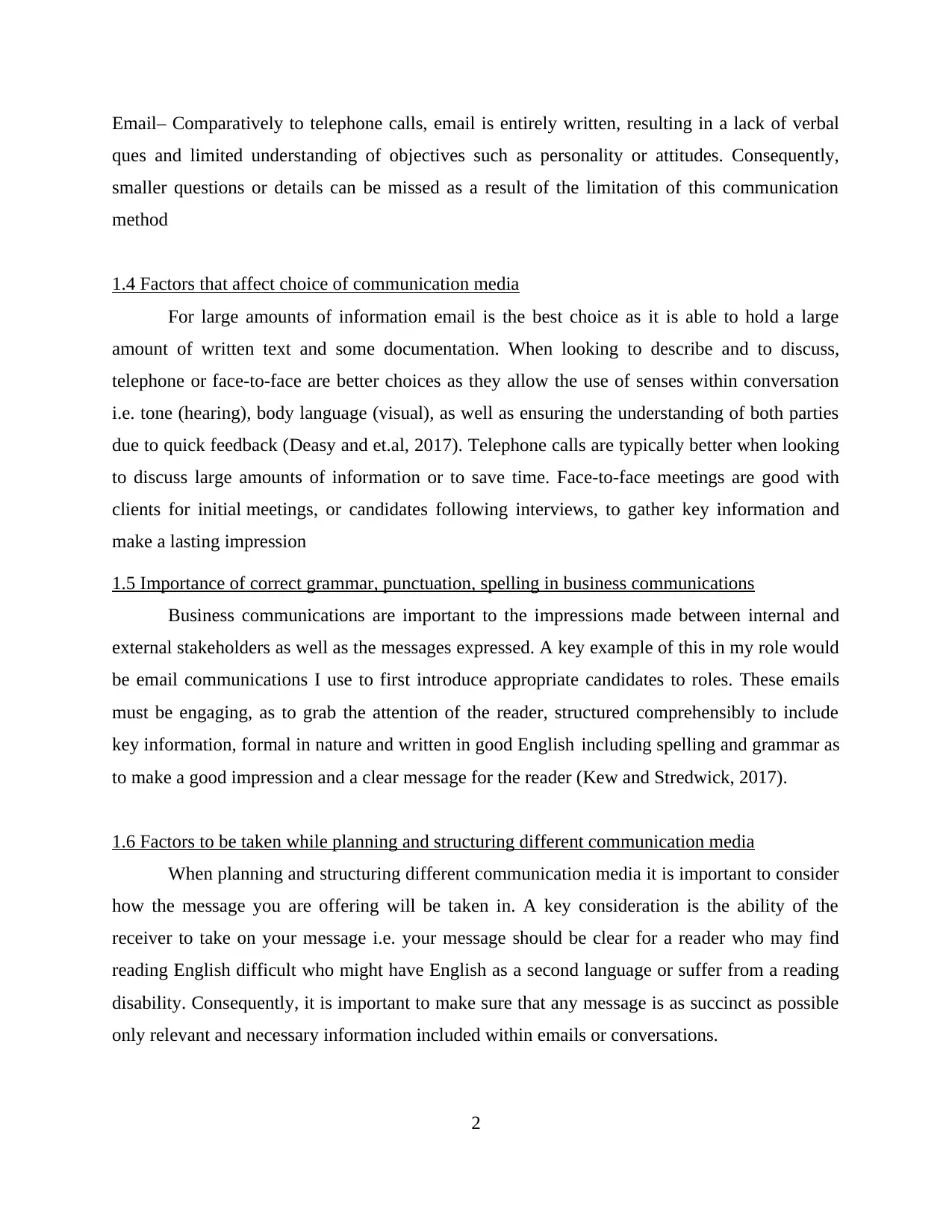
Email– Comparatively to telephone calls, email is entirely written, resulting in a lack of verbal
ques and limited understanding of objectives such as personality or attitudes. Consequently,
smaller questions or details can be missed as a result of the limitation of this communication
method
1.4 Factors that affect choice of communication media
For large amounts of information email is the best choice as it is able to hold a large
amount of written text and some documentation. When looking to describe and to discuss,
telephone or face-to-face are better choices as they allow the use of senses within conversation
i.e. tone (hearing), body language (visual), as well as ensuring the understanding of both parties
due to quick feedback (Deasy and et.al, 2017). Telephone calls are typically better when looking
to discuss large amounts of information or to save time. Face-to-face meetings are good with
clients for initial meetings, or candidates following interviews, to gather key information and
make a lasting impression
1.5 Importance of correct grammar, punctuation, spelling in business communications
Business communications are important to the impressions made between internal and
external stakeholders as well as the messages expressed. A key example of this in my role would
be email communications I use to first introduce appropriate candidates to roles. These emails
must be engaging, as to grab the attention of the reader, structured comprehensibly to include
key information, formal in nature and written in good English including spelling and grammar as
to make a good impression and a clear message for the reader (Kew and Stredwick, 2017).
1.6 Factors to be taken while planning and structuring different communication media
When planning and structuring different communication media it is important to consider
how the message you are offering will be taken in. A key consideration is the ability of the
receiver to take on your message i.e. your message should be clear for a reader who may find
reading English difficult who might have English as a second language or suffer from a reading
disability. Consequently, it is important to make sure that any message is as succinct as possible
only relevant and necessary information included within emails or conversations.
2
ques and limited understanding of objectives such as personality or attitudes. Consequently,
smaller questions or details can be missed as a result of the limitation of this communication
method
1.4 Factors that affect choice of communication media
For large amounts of information email is the best choice as it is able to hold a large
amount of written text and some documentation. When looking to describe and to discuss,
telephone or face-to-face are better choices as they allow the use of senses within conversation
i.e. tone (hearing), body language (visual), as well as ensuring the understanding of both parties
due to quick feedback (Deasy and et.al, 2017). Telephone calls are typically better when looking
to discuss large amounts of information or to save time. Face-to-face meetings are good with
clients for initial meetings, or candidates following interviews, to gather key information and
make a lasting impression
1.5 Importance of correct grammar, punctuation, spelling in business communications
Business communications are important to the impressions made between internal and
external stakeholders as well as the messages expressed. A key example of this in my role would
be email communications I use to first introduce appropriate candidates to roles. These emails
must be engaging, as to grab the attention of the reader, structured comprehensibly to include
key information, formal in nature and written in good English including spelling and grammar as
to make a good impression and a clear message for the reader (Kew and Stredwick, 2017).
1.6 Factors to be taken while planning and structuring different communication media
When planning and structuring different communication media it is important to consider
how the message you are offering will be taken in. A key consideration is the ability of the
receiver to take on your message i.e. your message should be clear for a reader who may find
reading English difficult who might have English as a second language or suffer from a reading
disability. Consequently, it is important to make sure that any message is as succinct as possible
only relevant and necessary information included within emails or conversations.
2
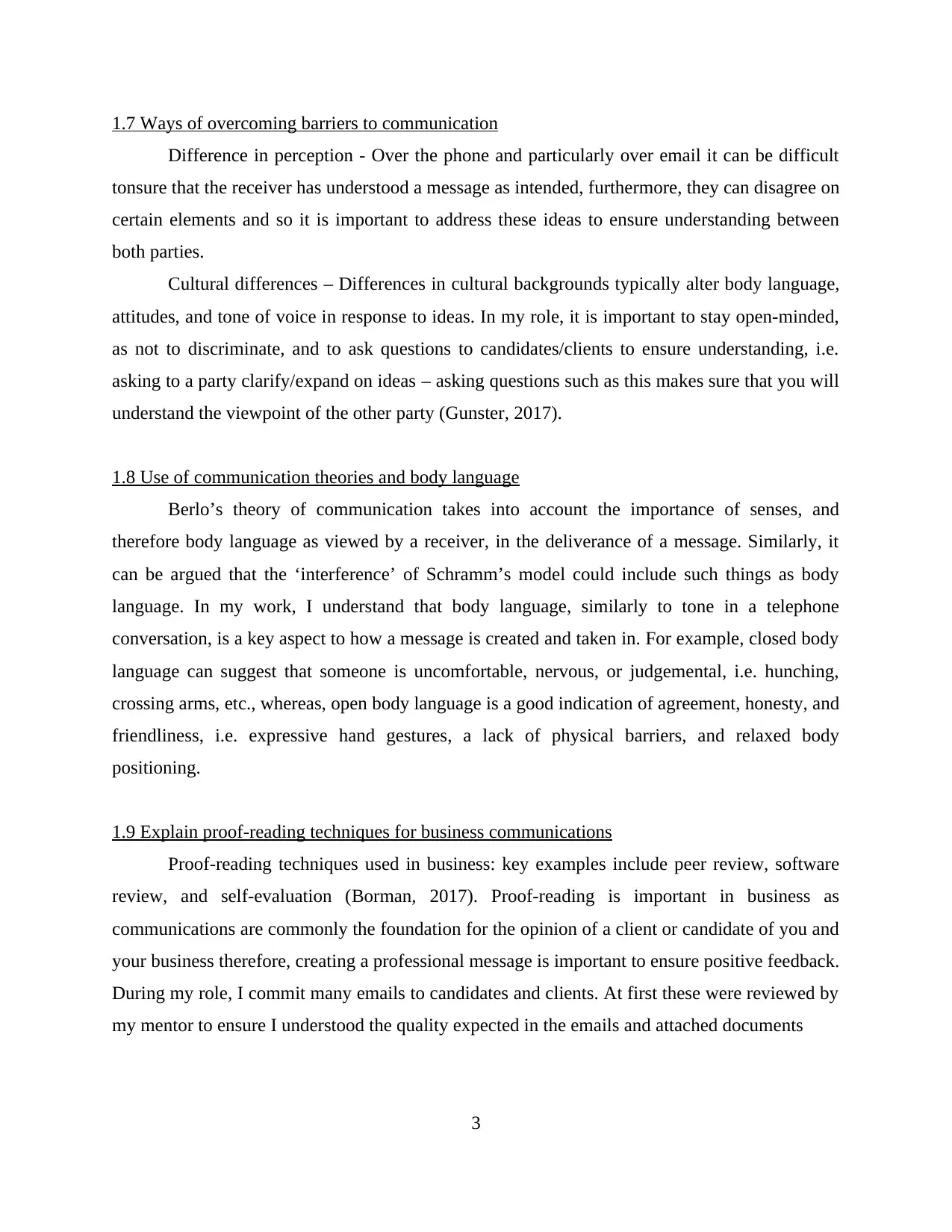
1.7 Ways of overcoming barriers to communication
Difference in perception - Over the phone and particularly over email it can be difficult
tonsure that the receiver has understood a message as intended, furthermore, they can disagree on
certain elements and so it is important to address these ideas to ensure understanding between
both parties.
Cultural differences – Differences in cultural backgrounds typically alter body language,
attitudes, and tone of voice in response to ideas. In my role, it is important to stay open-minded,
as not to discriminate, and to ask questions to candidates/clients to ensure understanding, i.e.
asking to a party clarify/expand on ideas – asking questions such as this makes sure that you will
understand the viewpoint of the other party (Gunster, 2017).
1.8 Use of communication theories and body language
Berlo’s theory of communication takes into account the importance of senses, and
therefore body language as viewed by a receiver, in the deliverance of a message. Similarly, it
can be argued that the ‘interference’ of Schramm’s model could include such things as body
language. In my work, I understand that body language, similarly to tone in a telephone
conversation, is a key aspect to how a message is created and taken in. For example, closed body
language can suggest that someone is uncomfortable, nervous, or judgemental, i.e. hunching,
crossing arms, etc., whereas, open body language is a good indication of agreement, honesty, and
friendliness, i.e. expressive hand gestures, a lack of physical barriers, and relaxed body
positioning.
1.9 Explain proof-reading techniques for business communications
Proof-reading techniques used in business: key examples include peer review, software
review, and self-evaluation (Borman, 2017). Proof-reading is important in business as
communications are commonly the foundation for the opinion of a client or candidate of you and
your business therefore, creating a professional message is important to ensure positive feedback.
During my role, I commit many emails to candidates and clients. At first these were reviewed by
my mentor to ensure I understood the quality expected in the emails and attached documents
3
Difference in perception - Over the phone and particularly over email it can be difficult
tonsure that the receiver has understood a message as intended, furthermore, they can disagree on
certain elements and so it is important to address these ideas to ensure understanding between
both parties.
Cultural differences – Differences in cultural backgrounds typically alter body language,
attitudes, and tone of voice in response to ideas. In my role, it is important to stay open-minded,
as not to discriminate, and to ask questions to candidates/clients to ensure understanding, i.e.
asking to a party clarify/expand on ideas – asking questions such as this makes sure that you will
understand the viewpoint of the other party (Gunster, 2017).
1.8 Use of communication theories and body language
Berlo’s theory of communication takes into account the importance of senses, and
therefore body language as viewed by a receiver, in the deliverance of a message. Similarly, it
can be argued that the ‘interference’ of Schramm’s model could include such things as body
language. In my work, I understand that body language, similarly to tone in a telephone
conversation, is a key aspect to how a message is created and taken in. For example, closed body
language can suggest that someone is uncomfortable, nervous, or judgemental, i.e. hunching,
crossing arms, etc., whereas, open body language is a good indication of agreement, honesty, and
friendliness, i.e. expressive hand gestures, a lack of physical barriers, and relaxed body
positioning.
1.9 Explain proof-reading techniques for business communications
Proof-reading techniques used in business: key examples include peer review, software
review, and self-evaluation (Borman, 2017). Proof-reading is important in business as
communications are commonly the foundation for the opinion of a client or candidate of you and
your business therefore, creating a professional message is important to ensure positive feedback.
During my role, I commit many emails to candidates and clients. At first these were reviewed by
my mentor to ensure I understood the quality expected in the emails and attached documents
3
⊘ This is a preview!⊘
Do you want full access?
Subscribe today to unlock all pages.

Trusted by 1+ million students worldwide
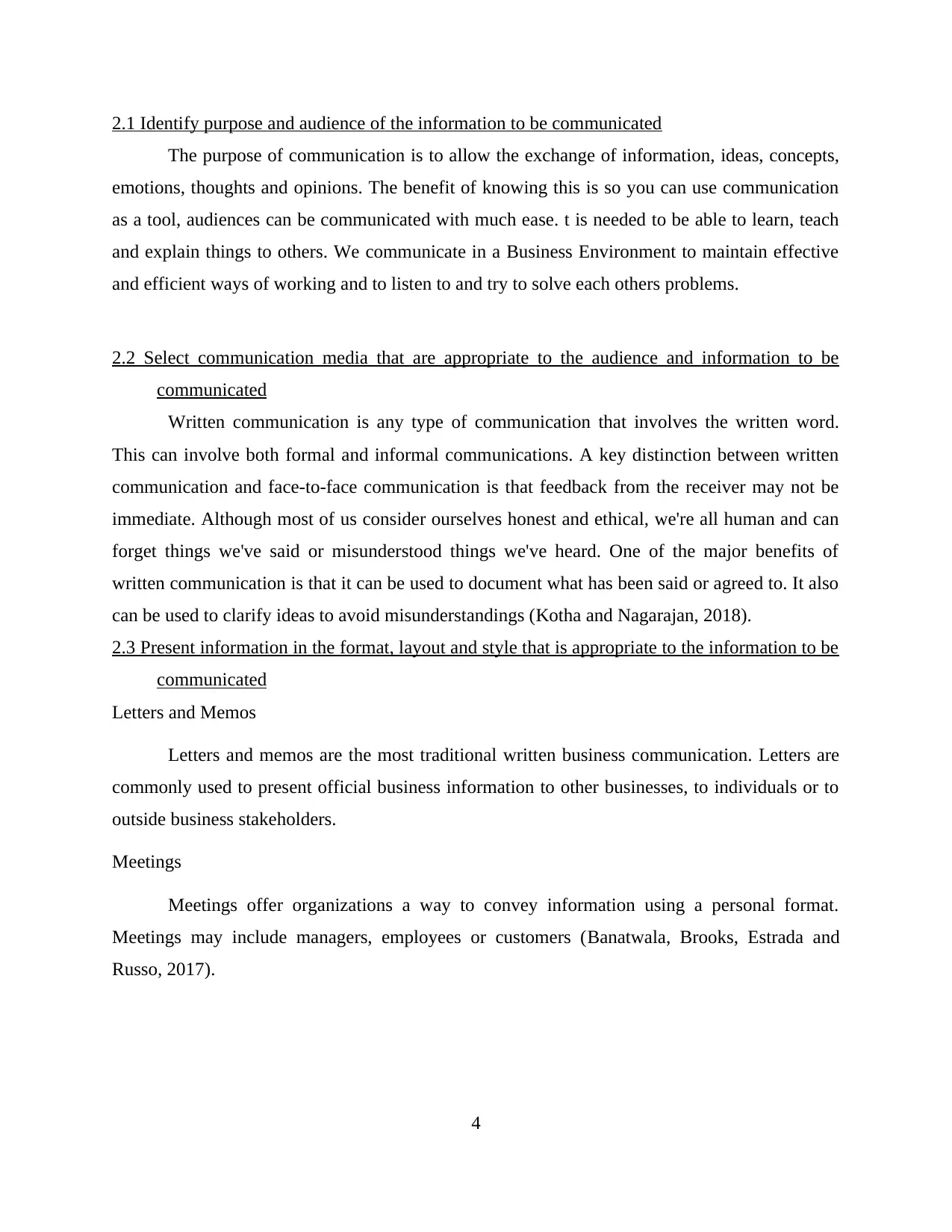
2.1 Identify purpose and audience of the information to be communicated
The purpose of communication is to allow the exchange of information, ideas, concepts,
emotions, thoughts and opinions. The benefit of knowing this is so you can use communication
as a tool, audiences can be communicated with much ease. t is needed to be able to learn, teach
and explain things to others. We communicate in a Business Environment to maintain effective
and efficient ways of working and to listen to and try to solve each others problems.
2.2 Select communication media that are appropriate to the audience and information to be
communicated
Written communication is any type of communication that involves the written word.
This can involve both formal and informal communications. A key distinction between written
communication and face-to-face communication is that feedback from the receiver may not be
immediate. Although most of us consider ourselves honest and ethical, we're all human and can
forget things we've said or misunderstood things we've heard. One of the major benefits of
written communication is that it can be used to document what has been said or agreed to. It also
can be used to clarify ideas to avoid misunderstandings (Kotha and Nagarajan, 2018).
2.3 Present information in the format, layout and style that is appropriate to the information to be
communicated
Letters and Memos
Letters and memos are the most traditional written business communication. Letters are
commonly used to present official business information to other businesses, to individuals or to
outside business stakeholders.
Meetings
Meetings offer organizations a way to convey information using a personal format.
Meetings may include managers, employees or customers (Banatwala, Brooks, Estrada and
Russo, 2017).
4
The purpose of communication is to allow the exchange of information, ideas, concepts,
emotions, thoughts and opinions. The benefit of knowing this is so you can use communication
as a tool, audiences can be communicated with much ease. t is needed to be able to learn, teach
and explain things to others. We communicate in a Business Environment to maintain effective
and efficient ways of working and to listen to and try to solve each others problems.
2.2 Select communication media that are appropriate to the audience and information to be
communicated
Written communication is any type of communication that involves the written word.
This can involve both formal and informal communications. A key distinction between written
communication and face-to-face communication is that feedback from the receiver may not be
immediate. Although most of us consider ourselves honest and ethical, we're all human and can
forget things we've said or misunderstood things we've heard. One of the major benefits of
written communication is that it can be used to document what has been said or agreed to. It also
can be used to clarify ideas to avoid misunderstandings (Kotha and Nagarajan, 2018).
2.3 Present information in the format, layout and style that is appropriate to the information to be
communicated
Letters and Memos
Letters and memos are the most traditional written business communication. Letters are
commonly used to present official business information to other businesses, to individuals or to
outside business stakeholders.
Meetings
Meetings offer organizations a way to convey information using a personal format.
Meetings may include managers, employees or customers (Banatwala, Brooks, Estrada and
Russo, 2017).
4
Paraphrase This Document
Need a fresh take? Get an instant paraphrase of this document with our AI Paraphraser
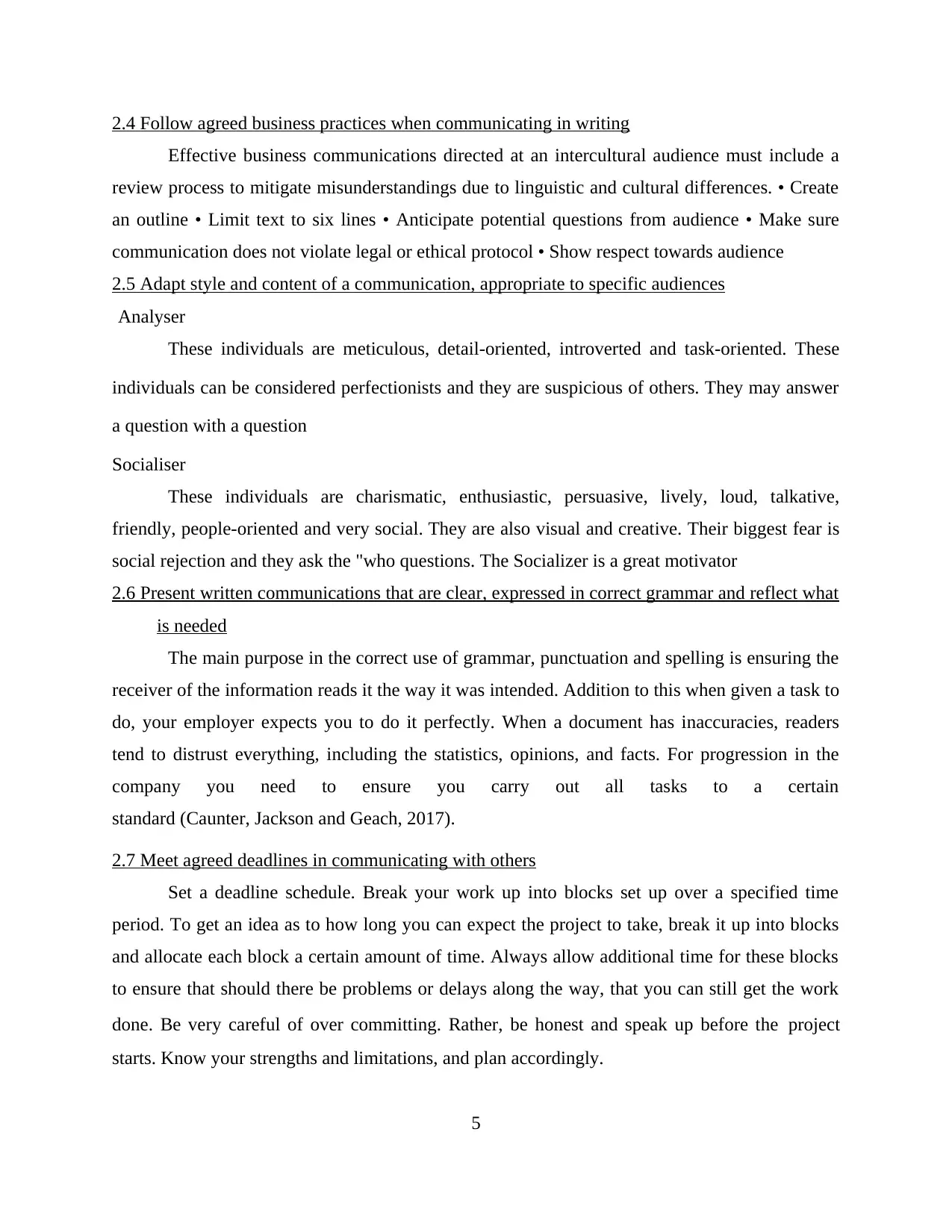
2.4 Follow agreed business practices when communicating in writing
Effective business communications directed at an intercultural audience must include a
review process to mitigate misunderstandings due to linguistic and cultural differences. • Create
an outline • Limit text to six lines • Anticipate potential questions from audience • Make sure
communication does not violate legal or ethical protocol • Show respect towards audience
2.5 Adapt style and content of a communication, appropriate to specific audiences
Analyser
These individuals are meticulous, detail-oriented, introverted and task-oriented. These
individuals can be considered perfectionists and they are suspicious of others. They may answer
a question with a question
Socialiser
These individuals are charismatic, enthusiastic, persuasive, lively, loud, talkative,
friendly, people-oriented and very social. They are also visual and creative. Their biggest fear is
social rejection and they ask the "who questions. The Socializer is a great motivator
2.6 Present written communications that are clear, expressed in correct grammar and reflect what
is needed
The main purpose in the correct use of grammar, punctuation and spelling is ensuring the
receiver of the information reads it the way it was intended. Addition to this when given a task to
do, your employer expects you to do it perfectly. When a document has inaccuracies, readers
tend to distrust everything, including the statistics, opinions, and facts. For progression in the
company you need to ensure you carry out all tasks to a certain
standard (Caunter, Jackson and Geach, 2017).
2.7 Meet agreed deadlines in communicating with others
Set a deadline schedule. Break your work up into blocks set up over a specified time
period. To get an idea as to how long you can expect the project to take, break it up into blocks
and allocate each block a certain amount of time. Always allow additional time for these blocks
to ensure that should there be problems or delays along the way, that you can still get the work
done. Be very careful of over committing. Rather, be honest and speak up before the project
starts. Know your strengths and limitations, and plan accordingly.
5
Effective business communications directed at an intercultural audience must include a
review process to mitigate misunderstandings due to linguistic and cultural differences. • Create
an outline • Limit text to six lines • Anticipate potential questions from audience • Make sure
communication does not violate legal or ethical protocol • Show respect towards audience
2.5 Adapt style and content of a communication, appropriate to specific audiences
Analyser
These individuals are meticulous, detail-oriented, introverted and task-oriented. These
individuals can be considered perfectionists and they are suspicious of others. They may answer
a question with a question
Socialiser
These individuals are charismatic, enthusiastic, persuasive, lively, loud, talkative,
friendly, people-oriented and very social. They are also visual and creative. Their biggest fear is
social rejection and they ask the "who questions. The Socializer is a great motivator
2.6 Present written communications that are clear, expressed in correct grammar and reflect what
is needed
The main purpose in the correct use of grammar, punctuation and spelling is ensuring the
receiver of the information reads it the way it was intended. Addition to this when given a task to
do, your employer expects you to do it perfectly. When a document has inaccuracies, readers
tend to distrust everything, including the statistics, opinions, and facts. For progression in the
company you need to ensure you carry out all tasks to a certain
standard (Caunter, Jackson and Geach, 2017).
2.7 Meet agreed deadlines in communicating with others
Set a deadline schedule. Break your work up into blocks set up over a specified time
period. To get an idea as to how long you can expect the project to take, break it up into blocks
and allocate each block a certain amount of time. Always allow additional time for these blocks
to ensure that should there be problems or delays along the way, that you can still get the work
done. Be very careful of over committing. Rather, be honest and speak up before the project
starts. Know your strengths and limitations, and plan accordingly.
5
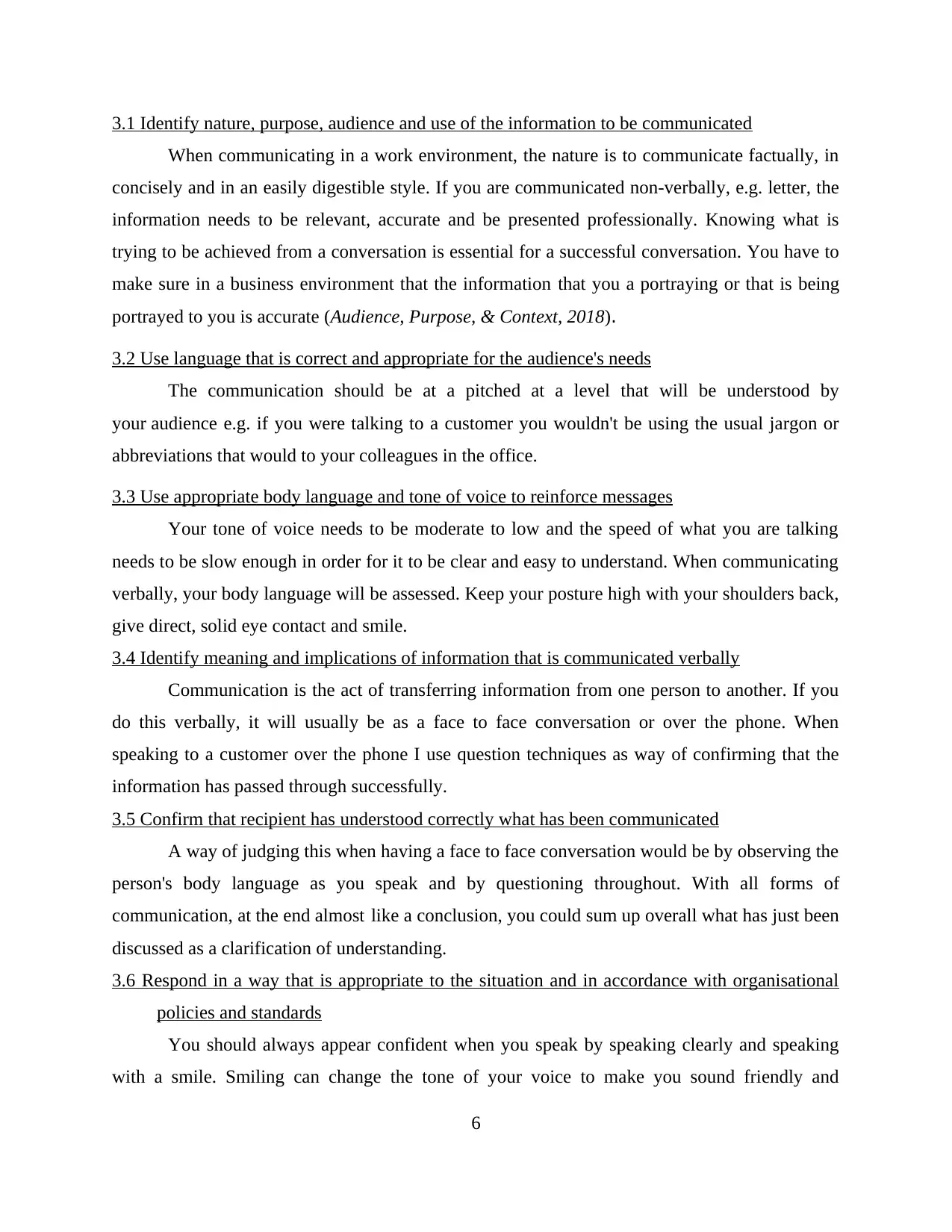
3.1 Identify nature, purpose, audience and use of the information to be communicated
When communicating in a work environment, the nature is to communicate factually, in
concisely and in an easily digestible style. If you are communicated non-verbally, e.g. letter, the
information needs to be relevant, accurate and be presented professionally. Knowing what is
trying to be achieved from a conversation is essential for a successful conversation. You have to
make sure in a business environment that the information that you a portraying or that is being
portrayed to you is accurate (Audience, Purpose, & Context, 2018).
3.2 Use language that is correct and appropriate for the audience's needs
The communication should be at a pitched at a level that will be understood by
your audience e.g. if you were talking to a customer you wouldn't be using the usual jargon or
abbreviations that would to your colleagues in the office.
3.3 Use appropriate body language and tone of voice to reinforce messages
Your tone of voice needs to be moderate to low and the speed of what you are talking
needs to be slow enough in order for it to be clear and easy to understand. When communicating
verbally, your body language will be assessed. Keep your posture high with your shoulders back,
give direct, solid eye contact and smile.
3.4 Identify meaning and implications of information that is communicated verbally
Communication is the act of transferring information from one person to another. If you
do this verbally, it will usually be as a face to face conversation or over the phone. When
speaking to a customer over the phone I use question techniques as way of confirming that the
information has passed through successfully.
3.5 Confirm that recipient has understood correctly what has been communicated
A way of judging this when having a face to face conversation would be by observing the
person's body language as you speak and by questioning throughout. With all forms of
communication, at the end almost like a conclusion, you could sum up overall what has just been
discussed as a clarification of understanding.
3.6 Respond in a way that is appropriate to the situation and in accordance with organisational
policies and standards
You should always appear confident when you speak by speaking clearly and speaking
with a smile. Smiling can change the tone of your voice to make you sound friendly and
6
When communicating in a work environment, the nature is to communicate factually, in
concisely and in an easily digestible style. If you are communicated non-verbally, e.g. letter, the
information needs to be relevant, accurate and be presented professionally. Knowing what is
trying to be achieved from a conversation is essential for a successful conversation. You have to
make sure in a business environment that the information that you a portraying or that is being
portrayed to you is accurate (Audience, Purpose, & Context, 2018).
3.2 Use language that is correct and appropriate for the audience's needs
The communication should be at a pitched at a level that will be understood by
your audience e.g. if you were talking to a customer you wouldn't be using the usual jargon or
abbreviations that would to your colleagues in the office.
3.3 Use appropriate body language and tone of voice to reinforce messages
Your tone of voice needs to be moderate to low and the speed of what you are talking
needs to be slow enough in order for it to be clear and easy to understand. When communicating
verbally, your body language will be assessed. Keep your posture high with your shoulders back,
give direct, solid eye contact and smile.
3.4 Identify meaning and implications of information that is communicated verbally
Communication is the act of transferring information from one person to another. If you
do this verbally, it will usually be as a face to face conversation or over the phone. When
speaking to a customer over the phone I use question techniques as way of confirming that the
information has passed through successfully.
3.5 Confirm that recipient has understood correctly what has been communicated
A way of judging this when having a face to face conversation would be by observing the
person's body language as you speak and by questioning throughout. With all forms of
communication, at the end almost like a conclusion, you could sum up overall what has just been
discussed as a clarification of understanding.
3.6 Respond in a way that is appropriate to the situation and in accordance with organisational
policies and standards
You should always appear confident when you speak by speaking clearly and speaking
with a smile. Smiling can change the tone of your voice to make you sound friendly and
6
⊘ This is a preview!⊘
Do you want full access?
Subscribe today to unlock all pages.

Trusted by 1+ million students worldwide
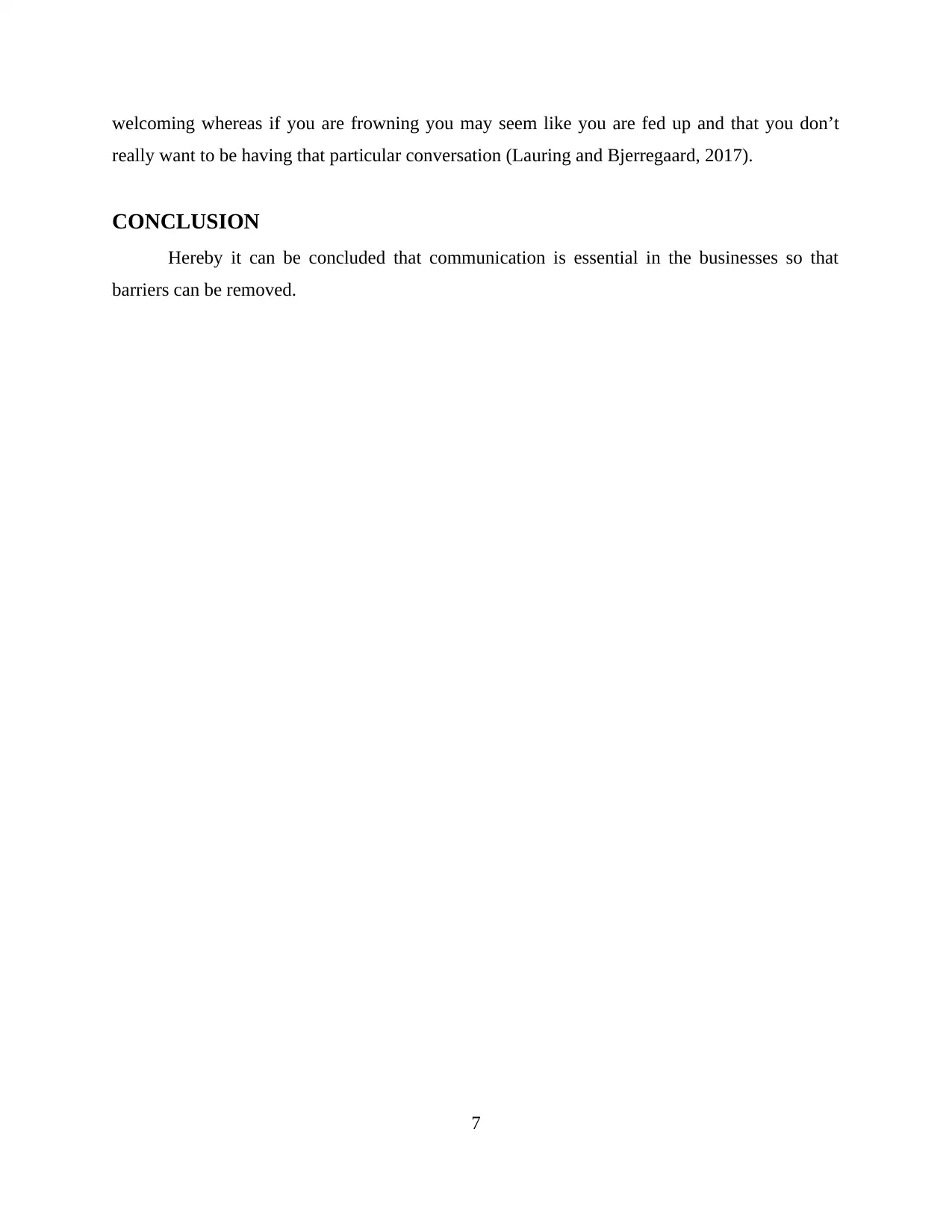
welcoming whereas if you are frowning you may seem like you are fed up and that you don’t
really want to be having that particular conversation (Lauring and Bjerregaard, 2017).
CONCLUSION
Hereby it can be concluded that communication is essential in the businesses so that
barriers can be removed.
7
really want to be having that particular conversation (Lauring and Bjerregaard, 2017).
CONCLUSION
Hereby it can be concluded that communication is essential in the businesses so that
barriers can be removed.
7
Paraphrase This Document
Need a fresh take? Get an instant paraphrase of this document with our AI Paraphraser
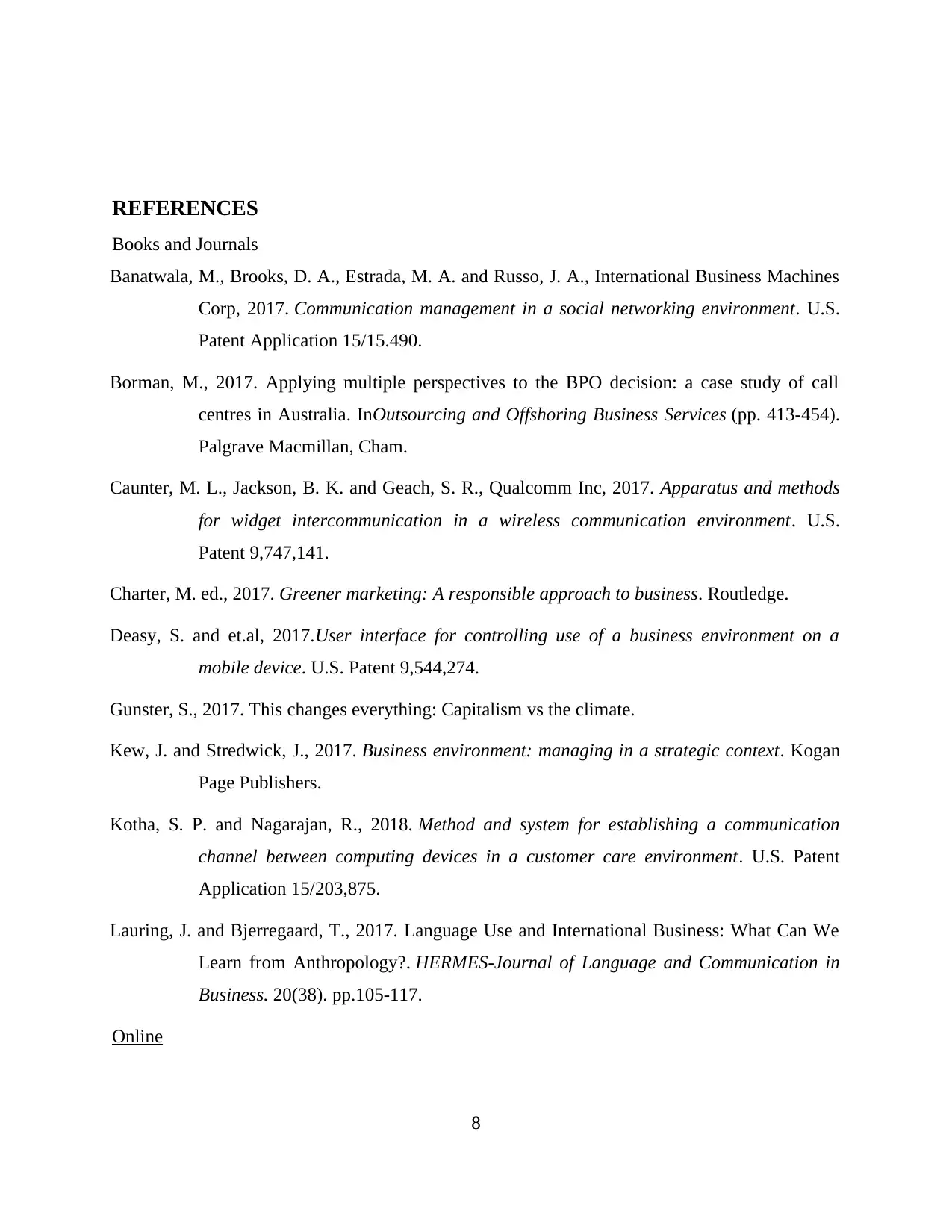
REFERENCES
Books and Journals
Banatwala, M., Brooks, D. A., Estrada, M. A. and Russo, J. A., International Business Machines
Corp, 2017. Communication management in a social networking environment. U.S.
Patent Application 15/15.490.
Borman, M., 2017. Applying multiple perspectives to the BPO decision: a case study of call
centres in Australia. InOutsourcing and Offshoring Business Services (pp. 413-454).
Palgrave Macmillan, Cham.
Caunter, M. L., Jackson, B. K. and Geach, S. R., Qualcomm Inc, 2017. Apparatus and methods
for widget intercommunication in a wireless communication environment. U.S.
Patent 9,747,141.
Charter, M. ed., 2017. Greener marketing: A responsible approach to business. Routledge.
Deasy, S. and et.al, 2017.User interface for controlling use of a business environment on a
mobile device. U.S. Patent 9,544,274.
Gunster, S., 2017. This changes everything: Capitalism vs the climate.
Kew, J. and Stredwick, J., 2017. Business environment: managing in a strategic context. Kogan
Page Publishers.
Kotha, S. P. and Nagarajan, R., 2018. Method and system for establishing a communication
channel between computing devices in a customer care environment. U.S. Patent
Application 15/203,875.
Lauring, J. and Bjerregaard, T., 2017. Language Use and International Business: What Can We
Learn from Anthropology?. HERMES-Journal of Language and Communication in
Business. 20(38). pp.105-117.
Online
8
Books and Journals
Banatwala, M., Brooks, D. A., Estrada, M. A. and Russo, J. A., International Business Machines
Corp, 2017. Communication management in a social networking environment. U.S.
Patent Application 15/15.490.
Borman, M., 2017. Applying multiple perspectives to the BPO decision: a case study of call
centres in Australia. InOutsourcing and Offshoring Business Services (pp. 413-454).
Palgrave Macmillan, Cham.
Caunter, M. L., Jackson, B. K. and Geach, S. R., Qualcomm Inc, 2017. Apparatus and methods
for widget intercommunication in a wireless communication environment. U.S.
Patent 9,747,141.
Charter, M. ed., 2017. Greener marketing: A responsible approach to business. Routledge.
Deasy, S. and et.al, 2017.User interface for controlling use of a business environment on a
mobile device. U.S. Patent 9,544,274.
Gunster, S., 2017. This changes everything: Capitalism vs the climate.
Kew, J. and Stredwick, J., 2017. Business environment: managing in a strategic context. Kogan
Page Publishers.
Kotha, S. P. and Nagarajan, R., 2018. Method and system for establishing a communication
channel between computing devices in a customer care environment. U.S. Patent
Application 15/203,875.
Lauring, J. and Bjerregaard, T., 2017. Language Use and International Business: What Can We
Learn from Anthropology?. HERMES-Journal of Language and Communication in
Business. 20(38). pp.105-117.
Online
8
1 out of 11
Related Documents
Your All-in-One AI-Powered Toolkit for Academic Success.
+13062052269
info@desklib.com
Available 24*7 on WhatsApp / Email
![[object Object]](/_next/static/media/star-bottom.7253800d.svg)
Unlock your academic potential
Copyright © 2020–2025 A2Z Services. All Rights Reserved. Developed and managed by ZUCOL.





